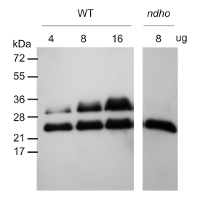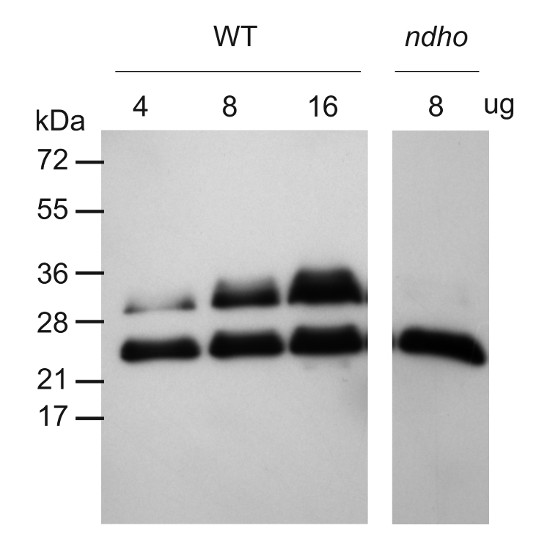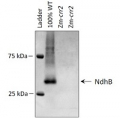1

Anti-NdhS | NAD(P)H-quinone oxidoreductase subunit S (chloroplastic)
AS16 4066 | Clonality: Polyclonal | Host: Rabbit | Reactivity: Arabidopsis thaliana, Hordeum vulgare
- Product Info
-
Immunogen: KLH-conjugated synthetic peptide dervied from Arabidopsis thaliana NdhS sequence, UniProt: A0A178V0R5, TAIR: AT4G23890
Host: Rabbit Clonality: Polyclonal Purity: Immunogen affinity purified serum in PBS pH 7.4. Format: Lyophilized Quantity: 50 µg Reconstitution: For reconstitution add 50 µl of sterile water Storage: Store lyophilized/reconstituted at -20°C; once reconstituted make aliquots to avoid repeated freeze-thaw cycles. Please remember to spin the tubes briefly prior to opening them to avoid any losses that might occur from material adhering to the cap or sides of the tube. Tested applications: Western blot (WB) Recommended dilution: 1:10 000 (WB)
Expected | apparent MW: 27 kDa
- Reactivity
-
Confirmed reactivity: Arabidopsis thaliana, Hordeum vulgare Predicted reactivity: Trema orientale, Parasponia andersonii, Populus tomentosa, Prunus avium, Raphanus sativus, Ziziphus jujuba
Species of your interest not listed? Contact usNot reactive in: No confirmed exceptions from predicted reactivity are currently known - Application Examples
-
Application example 
Arabidopsis thaliana leaves from wildtype and ndho mutant were frozen in liquid nitrogen. Leaf tissue was homogenized in ice-cold isolation buffer (330 mm Suc, 25 mm HEPES-KOH, pH 7.4, 10 mm MgCl2, and 10 mm NaF) and filtered through Miracloth. The filtrate was centrifuged at 6,000g for 5 min at 4°C. The thylakoid pellet was resuspended in 25 mm HEPES-KOH, pH 7.4, 10 mm MgCl2, and 10 mm NaF, centrifuged at 6,000g, for 5 min at 4°C, and finally suspended in the isolation buffer and stored at −80°C. The chlorophyll content of isolated thylakoids was determined according to Porra et al. (1989)
Samples were denatured with Laemmli buffer at 65°C for 5 min. and were separated on 12 % SDS-PAGE and blotted 1h to PVDF (0.45um), using semi-dry transfer. Blot was blocked with 5 % milk 1h/RT with agitation. Blot was incubated in the primary antibody at a dilution of 1: 10000 in TBS-T ON/4°C with agitation. The antibody solution was decanted and the blot washed once for 15 min and 3 times for 5 min in TBS-T at RT with agitation. Blot was incubated in Agrisera matching secondary antibody (anti-rabbit IgG horse radish peroxidase conjugated) diluted to 1:25 000 in for 1h/RT with agitation. The blot was washed as above and incubated for 5min min with chemiluminescent detection reagents. Exposure time was 5-10 min.
Courtesy Dr. Lauri Nikkanen, University of Turku, Finland - Background
-
Background: NAD(P)H-quinone oxidoreductase subunit 2 is involved in the transfer of electrons from NAD(P)H:plastoquinone, via FMN and iron-sulfur centers, to quinones in the photosynthetic chain and possibly in a chloroplast respiratory chain. Alternative names: NAD(P)H dehydrogenase, subunit 2, NADH-plastoquinone oxidoreductase subunit 2.
- Product Citations
-
Selected references: Degen et al. (2023). PGR5 is required to avoid photosynthetic oscillations during light transitions. J Exp Bot. 2023 Oct 28:erad428.doi: 10.1093/jxb/erad428.
Nikkanen et al. (2018). Regulation of cyclic electron flow by chloroplast NADPH‐dependent thioredoxin system. Plant Direct https://doi.org/10.1002/pld3.93 - Reviews:
-
This product doesn't have any reviews.


